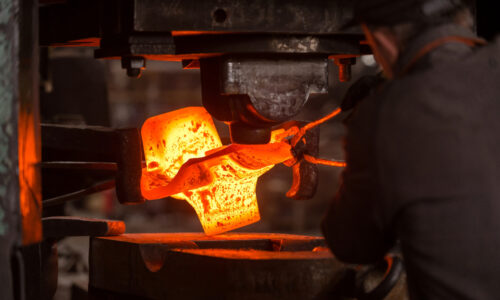Casting and forging are two primary metal forming processes widely used in industries such as machinery, automotive, and aerospace. While both aim to shape metals into desired forms, their principles, applications, and performance characteristics differ significantly. This article provides a comprehensive comparison of casting and forging in terms of process principles, advantages and disadvantages, and application areas.
1. Process Principles
1. Casting
Casting involves heating metal to its molten state and pouring it into a pre-prepared mold. Once the metal cools and solidifies, the mold is removed to obtain the desired part. Casting can be categorized into various types, including sand casting, precision casting, and die casting, depending on the mold and process.
2. Forging
Forging involves applying external forces to deform metal plastically, altering its shape and internal structure. Forging can be divided into hot forging, cold forging, and warm forging. Common equipment includes forging hammers, presses, and hydraulic presses.
2. Characteristics, Advantages, and Disadvantages
1. Characteristics of Casting
- Advantages
- Complex Shape Processing: Casting is ideal for manufacturing components with intricate shapes and internal cavities, such as engine blocks and turbine casings.
- Material Adaptability: Almost all metals, including steel, iron, aluminum, copper, and their alloys, can be cast.
- Size Flexibility: Cast parts can range from a few grams to several tons, meeting diverse specification requirements.
- Lower Costs: Casting molds are generally less expensive than forging equipment, making it suitable for mass production.
- Disadvantages
- Material Defect Risk: Issues such as shrinkage, porosity, and segregation may occur during cooling, affecting the internal quality of cast parts.
- Lower Mechanical Properties: Cast parts usually have coarser grains, resulting in lower strength and toughness compared to forged parts.
2. Characteristics of Forging
- Advantages
- High Mechanical Performance: Forging refines the metal’s grain structure, reduces internal defects, and significantly enhances strength, toughness, and fatigue resistance.
- High Density: Forged parts have continuous metal flow lines and dense structures, enabling them to withstand higher mechanical loads.
- High Reliability: Forged parts exhibit more uniform performance, making them suitable for demanding engineering applications.
- Disadvantages
- Limited Shape Complexity: Forging is less suited for parts with intricate shapes, especially those with internal cavities.
- Material Waste: Excess metal is often removed during forging, resulting in lower material utilization.
- Higher Costs: Forging equipment is expensive, and the process requires more energy and labor.
3. Application Scenarios
1. Applications of Casting
Casting is suited for producing parts with complex shapes and moderate precision requirements, such as:
- Automotive Industry: Engine blocks, crankcases, and axles.
- Aerospace: Turbine casings and jet engine components.
- Machinery Manufacturing: Valve bodies and pump casings.
2. Applications of Forging
Forging is ideal for parts requiring high strength and toughness, such as:
- Automotive Industry: Crankshafts, gears, and connecting rods.
- Aerospace: Aircraft landing gear and turbine disks.
- Energy Sector: Wind turbine main shafts and critical components for nuclear power equipment.
4. Performance Comparison
| Comparison Criteria | Casting | Forging |
|---|---|---|
| Material Utilization | High, but with some casting residues | Low, with more material waste |
| Shape Complexity | Suitable for complex shapes | Limited to simpler, symmetric shapes |
| Internal Defects | Higher likelihood of defects | Fewer defects, more reliable |
| Mechanical Properties | Lower | Higher |
| Production Costs | Lower mold costs, moderate overall | Higher equipment and production costs |
5. Future Trends
With technological advancements, casting and forging processes are increasingly merging and evolving:
- Intelligent and Automated Processes: Smart technologies, such as computer numerical simulation, are being integrated into casting and forging to optimize process design.
- New Materials and Techniques: Lightweight, high-performance materials (e.g., titanium alloys, magnesium alloys) are driving innovations in both casting and forging.
- Green Manufacturing: Environmentally friendly processes are being developed to reduce waste and improve energy efficiency.
6. Conclusion
Casting and forging, as two major metal forming processes, each have unique advantages and limitations. The choice between them depends on factors such as performance requirements, shape complexity, and production costs. Casting is better suited for complex parts with moderate performance demands, while forging excels in producing high-strength, high-toughness components. Looking ahead, the integration of casting and forging technologies will further advance manufacturing, offering more diverse and efficient solutions for industrial production.

